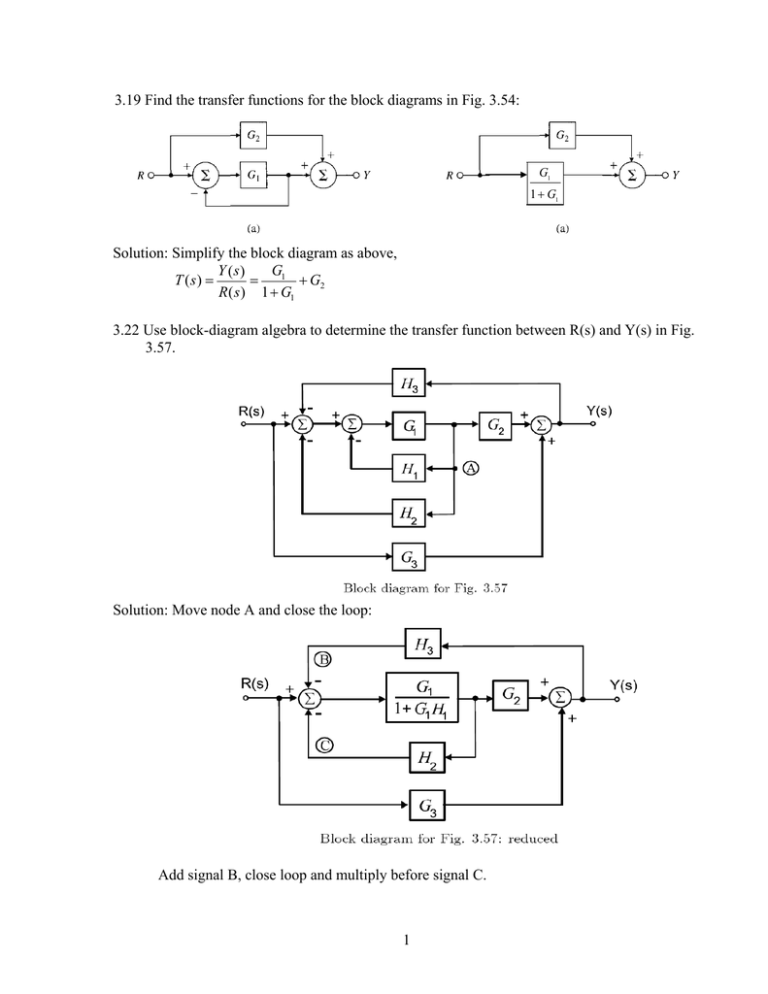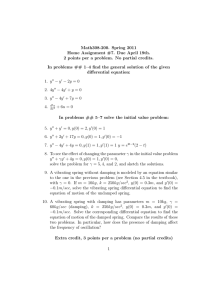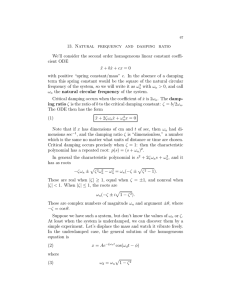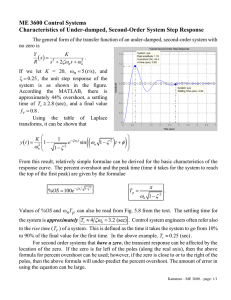Control Systems: Transfer Functions & Block Diagram Algebra
advertisement

3.19 Find the transfer functions for the block diagrams in Fig. 3.54:
G1
1 + G1
Solution: Simplify the block diagram as above,
Y ( s)
G1
T (s) =
=
+ G2
R( s ) 1 + G1
3.22 Use block-diagram algebra to determine the transfer function between R(s) and Y(s) in Fig.
3.57.
Solution: Move node A and close the loop:
Add signal B, close loop and multiply before signal C.
1
Move middle block N past summer.
Now reverse order of summers and close each block separately.
Y 1
)
= ( N + G3 ) (
1 + NH 3
R
feedforward
feedback
Y G1G2 + G3 (1 + G1 H1 + G1 H 2 )
=
R 1 + G1 H1 + G1 H 2 + G1G2 H 3
2
3.24 For the unity feedback system shown in Fig. 3.59, specify the gain K of the proportional
controller so that the output y (t ) has an overshoot of no more than 10% in response to a
unit step.
Solution:
Y ( s)
K
ωn2
= 2
= 2
R( s ) s + 2 s + K s + 2ζωn s + ωn2
ωn = K ,
1
(1)
2ωn
K
In order to have an overshoot of no more than 10%,
ζ =
2
=
M p = e −πζ /
1−ζ 2
≤ 0.10
Solving for ζ ,
ζ =
(ln M p ) 2
π 2 + (ln M p ) 2
≥ 0.591
Using (1) and the solution for ζ ,
K=
1
ζ2
≤ 2.86
∴ 0 ≤ K ≤ 2.86
3.28 The open-loop transfer function of a unity feedback system is
K
G(s) =
s ( s + 2)
The desired system response to a step input is specified as peak time t p = 1 sec
and overshoot M p = 5%.
(a) Determine whether both specifications can be met simultaneously by selecting
the right value of K.
(b) Sketch the associated region in the s-plane where both specifications are met,
and indicate what root locations are possible for some likely values of K.
(c) Pick a suitable value for K, and use MATLAB to verify that the specifications
are satisfied.
Solution:
3
(a)
T ( s) =
ωn2
Y (s)
G(s)
K
=
= 2
= 2
R( s ) 1 + G ( s ) s + 2s + K s + 2ζωn s + ωn2
Equate the coefficients:
2 = 2ζωn ,
⇒ ωn = K
K = ωn2
ζ =
We would need:
M p%
= 0.05 = e −πζ /
100
(*)
1
K
1−ζ 2
⇒ ζ = 0.69
π
π
=
⇒ ωn = 4.34
ωd ωn 1 − ζ 2
But the combination (ζ = 0.69, ωn = 4.34) that we need is not possible by varying K alone.
Observe that from equations (*) ζωn = 1 ≠ 0.69 × 4.34
t p = 1 sec =
(b)
4
(c) Now we wish to have:
M *p = r × 0.05 = e −πζ /
1−ζ 2
t *p = r × 1 sec =
,
π
ωd
where r ≡ relaxation factor.
Recall the conditions of our system:
1
K
replace ωn and ζ in the system (**):
ωn = K
⇒ e −π /
K −1
ζ =
π
= r × 0.05,
⇒ r × 0.05 = e − r ,
⇒
=r
K −1
r ≅ 2.21
π2
⇒ K = 3.02
r2
then with K = 3.02 we will have:
K = 1+
M *p = rM p = 2.21× 0.05 = 0.01
t *p = rt p = 2.21× 1 sec = 2.21 sec
Note: * denotes actual location of closed-loop roots.
% Problem 3.28
K=3.02;
num=[K];
den=[1, 2, K];
sys=tf(num,den);
t=0:.01:3;
y=step(sys,t);
plot(t,y);
yss = dcgain(sys);
Mp = (max(y) - yss)*100;
% Finding maximum overshoot
msg_overshoot = sprintf('Max overshoot = %3.2f%%', Mp);
% Finding peak time
idx = max(find(y==(max(y))));
tp = t(idx);
msg_peaktime = sprintf('Peak time = %3.2f', tp);
xlabel('Time (sec)');
ylabel('y(t)');
msg_title = sprintf('Step Response with K=%3.2f',K);
title(msg_title);
text(1.1, 0.3, msg_overshoot);
text(1.1, 0.1, msg_peaktime);
grid on;
5
(**)
A: Use matlab to plot the step response for ξ=0.2,0.4,0.6,0.8 for system
1
H (s) = 2
. Choose the final time as 15 seconds.
s + 2ξ s + 1
Solution:
% Problem 3.A
linespec=['r','g','b','k'];
t=0:.01:15;
for i=1:4
ci=i*0.2;
num=[1];
den=[1, 2*ci, 1];
sys=tf(num,den);
y=step(sys,t);
plot(t,y,linespec(i));
hold on;
6
end
legend('damping ratio = 0.2','damping ratio = 0.4','damping ratio = 0.6','damping ratio = 0.8');
xlabel('Time (sec)');
ylabel('y(t)');
title('Step Response with damping ratio = 0.2, 0.4, 0.6, 0.8');
grid on;
Step Response with damping ratio = 0.2, 0.4, 0.6, 0.8
1.6
damping
damping
damping
damping
1.4
1.2
ratio
ratio
ratio
ratio
=
=
=
=
0.2
0.4
0.6
0.8
y(t)
1
0.8
0.6
0.4
0.2
0
0
5
10
Time (sec)
7
15







